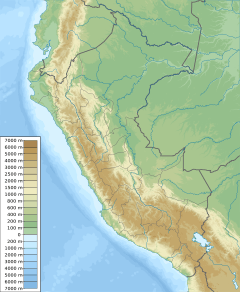"Cochranella" euhystrix facts for kids
Quick facts for kids "Cochranella" euhystrix |
|
|---|---|
| Conservation status | |
| Scientific classification | |
| Genus: |
"Cochranella"
|
| Species: |
euhystrix
|
| "Cochranella" euhystrix is only known from the vicinity of its type locality in Department of Cajamarca, Peru | |
| Synonyms | |
|
Centrolenella euhystrix Cadle and McDiarmid, 1990 |
|
The "Cochranella" euhystrix is a special kind of frog from the Centrolenidae family, also known as "glass frogs." This frog is quite unique because scientists are still figuring out its exact place within the glass frog group. That's why its genus name, Cochranella, is sometimes put in quotation marks.
This frog lives only in Peru, which means it's endemic there. It has only been found near a place called Cerro Blanco, in the Zaña River area of the Department of Cajamarca. The name euhystrix comes from Greek words meaning "very" and "porcupine." This name was chosen because the frog looks unusually spiny, especially the males. Some people call it the ridge Cochran frog.
What Does It Look Like?
Adult male frogs are about 2.9 to 3.1 centimeters (1.1 to 1.2 inches) long from their snout to their rear. Females are a bit bigger, measuring 3.1 to 3.4 centimeters (1.2 to 1.3 inches).
The frog's head is wider than its body. Its snout (nose area) is flat, but in females, it can be slightly rounded. You can see its eardrum, but it's partly covered by a thick fold of skin, especially in females.
Its fingers have small fringes on the sides and are partly webbed, like tiny paddles. Its toes are very webbed. All its fingers and toes have wide, flat pads at the ends.
The frog's back is dark greenish-black when it's active. When it's resting, it turns a dark green. These frogs can change their color very quickly! They have many tiny, light green spines, especially on their eyelids and lips. These spines make their upper body look like it's covered in tiny dots. Female frogs have fewer spines than males.
When male frogs want to attract a mate, they make a short "click" or "chirp" sound. Most of the time, their call has two quick notes, but sometimes it's just one note.
Where Does It Live and How Is It Doing?
This frog lives in mountain forests between 1,800 and 2,650 meters (5,900 to 8,700 feet) above sea level. It loves to be near mountain streams. You can often find these frogs on vertical rock faces, especially where waterfalls create a lot of spray or mist. They also like wet rocks covered in moss and liverworts in the middle of streams. They lay their eggs along these permanent, high-altitude streams.
Sadly, scientists looked for these frogs between 2006 and 2011 in the area where they were first found, but they couldn't find any. The area where they live is facing serious habitat loss and breaking up into smaller pieces. This problem even affects the Bosques Nublados de Udima Wildlife Refuge, which is a protected area within the frog's range. Even though it's a refuge, this frog hasn't been seen there.
This frog is listed as Critically Endangered by the IUCN (International Union for Conservation of Nature). This means it faces an extremely high risk of disappearing forever in the wild.



